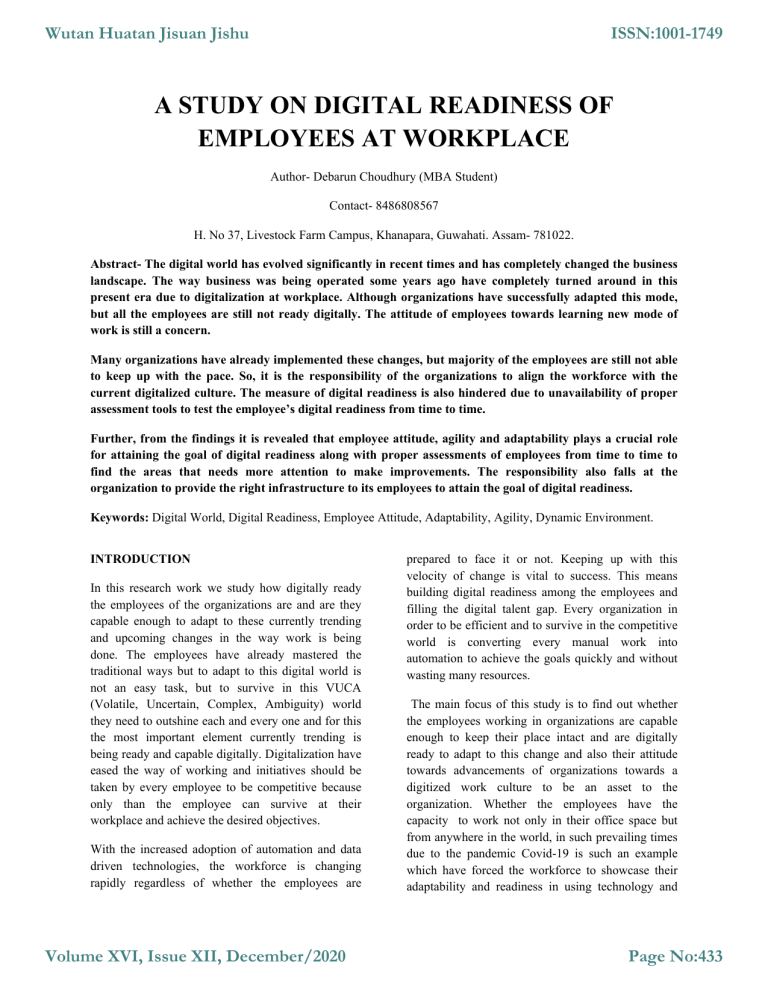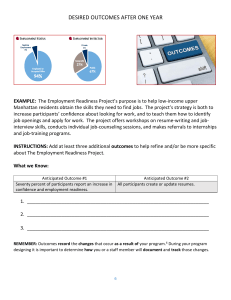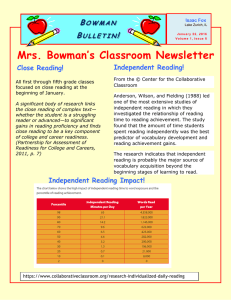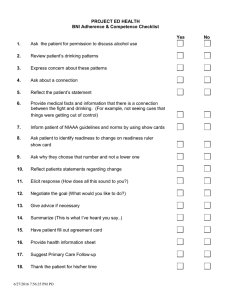
Wutan Huatan Jisuan Jishu ISSN:1001-1749 A STUDY ON DIGITAL READINESS OF EMPLOYEES AT WORKPLACE Author- Debarun Choudhury (MBA Student) Contact- 8486808567 H. No 37, Livestock Farm Campus, Khanapara, Guwahati. Assam- 781022. Abstract- The digital world has evolved significantly in recent times and has completely changed the business landscape. The way business was being operated some years ago have completely turned around in this present era due to digitalization at workplace. Although organizations have successfully adapted this mode, but all the employees are still not ready digitally. The attitude of employees towards learning new mode of work is still a concern. Many organizations have already implemented these changes, but majority of the employees are still not able to keep up with the pace. So, it is the responsibility of the organizations to align the workforce with the current digitalized culture. The measure of digital readiness is also hindered due to unavailability of proper assessment tools to test the employee’s digital readiness from time to time. Further, from the findings it is revealed that employee attitude, agility and adaptability plays a crucial role for attaining the goal of digital readiness along with proper assessments of employees from time to time to find the areas that needs more attention to make improvements. The responsibility also falls at the organization to provide the right infrastructure to its employees to attain the goal of digital readiness. Keywords: Digital World, Digital Readiness, Employee Attitude, Adaptability, Agility, Dynamic Environment. INTRODUCTION In this research work we study how digitally ready the employees of the organizations are and are they capable enough to adapt to these currently trending and upcoming changes in the way work is being done. The employees have already mastered the traditional ways but to adapt to this digital world is not an easy task, but to survive in this VUCA (Volatile, Uncertain, Complex, Ambiguity) world they need to outshine each and every one and for this the most important element currently trending is being ready and capable digitally. Digitalization have eased the way of working and initiatives should be taken by every employee to be competitive because only than the employee can survive at their workplace and achieve the desired objectives. With the increased adoption of automation and data driven technologies, the workforce is changing rapidly regardless of whether the employees are Volume XVI, Issue XII, December/2020 prepared to face it or not. Keeping up with this velocity of change is vital to success. This means building digital readiness among the employees and filling the digital talent gap. Every organization in order to be efficient and to survive in the competitive world is converting every manual work into automation to achieve the goals quickly and without wasting many resources. The main focus of this study is to find out whether the employees working in organizations are capable enough to keep their place intact and are digitally ready to adapt to this change and also their attitude towards advancements of organizations towards a digitized work culture to be an asset to the organization. Whether the employees have the capacity to work not only in their office space but from anywhere in the world, in such prevailing times due to the pandemic Covid-19 is such an example which have forced the workforce to showcase their adaptability and readiness in using technology and Page No:433 Wutan Huatan Jisuan Jishu ISSN:1001-1749 prove their worth to the organization. For the purpose of achieving digital readiness throughout the organization and the employees, it is necessary for the employees to have a learning attitude towards these new developments and need to work on their agility and adaptability, otherwise in current scenario the employees are being replaced quickly if they are not updated with latest changes happening around. Thus, digital readiness is the inclination and willingness to adapt and switch towards a digital technology and readiness of employees to bring in a change in the organizational, individual and industry to achieve their goals faster and efficiently with positive results. RESEARCH HYPOTHESIS PROBLEM, OBJECTIVE, 2.1. ProblemThe Research Problem identified is that the attitude of employees towards digital advancement at workplace is towards the resisting side and also the problem of being less adaptability towards change and agility is hampering the employees in achieving the goal of digital readiness. 2.2 Objectives1) To study the digital readiness of employees at workplace. 2) To study the attitude of employees towards digital advancement. 2.3. HypothesisHo: In changing environment, there is no significant relationship between adaptability to change and digital readiness. Ha: In changing environment, there is a significant relationship between adaptability to change and digital readiness. REVIEW OF LITERATURE Digital readiness basically means the digital ability or how ready the employees of organizations are to use digital medium to work at their workplace. The employees are the building blocks of any business Volume XVI, Issue XII, December/2020 and it is essential for organizations to train their employees to undertake digital transformation for personal and as well as for professional growth. For an organization to train every employee of the organization to be in sync with digital technology, the employees need to onboard the digital readiness train. The digital transformation strategy of every organization needs to be well prepared to accommodate various aspects of digitalization. It needs to have defined objective, a business plan, as well as a workforce ready to take on challenges that comes in the way of achieving digital readiness. Technology is making progress at a rapid speed and is altering the roles of employees. Digital transformation is challenging the business framework and with changing technology the workplace culture is also changing. The change towards attaining an environment of digital readiness can be achieved when there will be enough digital savvy leaders who can lead and transform the workplace. The digital savvy leaders are an added advantage to the digital transformation. (Kathpalia, 2020) Organizations future readiness can be defined based on four dimensions, i.e. organization, culture, employees and digital environment. To remain competitive and future ready and able to manage the current economic, political and social challenges as well as seize new growth opportunities, it is important that the companies consider all these dimensions (Deloitte, Digital Future Readiness, 2017). Digital readiness is the key for industry 4.0. Incorporating a digitally ready workforce is crucial to future competitiveness of the companies. The employees and customers are being closely networked while human and artificial intelligence and use of robots across the value chain is becoming a reality. The attitude of employees plays a crucial role in this aspect as at majority times we have seen that employees are reluctant to adapt and are less agile, which is not helping organizations towards creating a digitally ready workforce. The Cisco Global Digital Readiness Index research report is a study conducted by Cisco and Gartner Page No:434 Wutan Huatan Jisuan Jishu which analyzed multiple sources of data to create like-for-like measures to determine digital readiness scores for 118 countries. Countries included in the study were restricted to those with a population of more than three million, and those that were not the subject of significant trade embargoes. In total, 118 countries were scored on digital readiness based on seven components. These are: ISSN:1001-1749 accordingly measures can be taken towards becoming an effective digitally effective workforce. • Technology Infrastructure: Available to enable digital activities and connected consumers (Internet of Things, Cloud). • Technology Adoption: Demand for digital products and services. • Human Capital: Build and maintain a skilled labor force to support digital innovation. • Basic Human Needs: For a population to survive and thrive. • Ease of Doing Business: Basic infrastructure/policies needed to support business continuity. • Business and Government Investment: Private and public investment in innovation and technology. • Start-Up Environment: Environment which fosters innovation within a community. (Cisco, 2018). The Aon’s Digital Readiness Model can be applied in practice to assess and understand individuals, teams or the entire employee population's digital competencies. By using the ADEPT-15 personality questionnaire in combination with the cognitive ability test grid challenge you receive a comprehensive overview of a person's digital readiness. The result is a digital readiness profile highlighting how the person maps onto the model's eleven competencies. The model has been developed over years of analysis researching how people successfully work within digital environments. An assessment of personality and ability measures the level of digital competence, summarized in an individual report showing strengths and development areas. (Aon, 2020). This, the majority of organization’s poor digitally ready workforce is due to lack of proper assessment tools. Once the right tool is implemented, the weaknesses can be reported and Volume XVI, Issue XII, December/2020 (AON, 2020) Image- 1 Research GapDigital readiness in current scenario is not just a need but also a necessity to survive in the workplace. The attitude and behavior of employees plays a vital role in achieving the goal of digital readiness. A certain class or age group of employees are not that agile to be able to adapt to this change. The transformation is fast and due to lack of adaptability they are lacking behind from the millennial working class. The curiosity to learn something new often fades after a period of time so the organizations needs to keep in mind about this issue and regular assessments are needed to assess the employees and also keep them up to date with the latest changes in digital transformation. The employees are often reluctant to adapt to new working ways and are comfortable in their traditional methods of working. In this scenario, the organizations need to make these employees understand about such changes and their impact in the careers of such employees who are not ready digitally. Thus, for ensuring that the employees are ready digitally the organizations must ensure that right digital infrastructure is being provided to the employees and continuous assessments are being done from time to time for effective results. The employees also need to start working on them and improve their agility, adaptability, flexibility, mobility and so on. (Deloitte, Digital Future Readiness, 2017) Page No:435 Wutan Huatan Jisuan Jishu It is also essential to take certain psychometric tests of the employees to know about their cognitive abilities and their attitude towards a digital way of working as that would be beneficial to create an empathetic relationship as well as to build a training chart which can be followed to train the employees to create a digitally ready workforce. Employees with technical and cognitive digital skills help drive productivity, innovation, agility, and improved work quality. A digital-ready workforce achieves business objectives and digitally literate employees are more engaged in their day-to-day work and better equipped to adapt as technological advances evolve their roles. (Weise, 2015).Hence this research article focuses on the degree to which employees are ready to work efficiently using the digital platform. Also, this research aims to enhance the existing literature on digitalization by understanding the attitude of employees towards advancement in the digital world. RESEARCH METHODOLOGY Research DesignThe purpose of the study is to gain employees insights regarding how digitally ready they at their workplace are and what is their attitude towards getting ready digitally. The research design used is descriptive research design. Research MethodThe research method used for the research work is Quantitative Research Method. Area of ResearchThe area taken for the purpose of the research work is in the state of Maharashtra. ISSN:1001-1749 Sampling UnitThe questionnaire was circulated among employees of IT and Manufacturing Sector working in the state of Maharashtra. Statistical ToolThe statistical tool used for the research is SPSS Analysis. The hypothesis was tested on SPSS software using Spearman’s Correlation. DATA ANALYSIS Reliability Analysis. Reliability is the extent to which a questionnaire, test, observations or any measurement procedure produces an equivalent result on repeated trials. It is the stability or consistency scores over time or across responders. It is noted that reliability pertains to scores and not people. Thus, in the research it is never said that someone was reliable. The extent to which they agree on the scores for every contestant is a sign of reliability. Similarly, the degree to which an individual’s response (i.e., their scores) on a survey would stay the same over time is also a sign of reliability. This method is the most considered general forms of reliability estimation. In the internal consistency method, reliability is considered as internal consistency, which is the degree of inter correlation among the items that constitute a scale. It represents the level homogeneity in items of the scale. Internal consistency is measured using a reliability coefficient of Cronbach’s alpha. The standardized Cronbach’s coefficient alpha has been calculated for the 13 items of data collected. Sampling DesignThe sampling design implemented for the research wok is Simple Random Sampling. Sample Size- Table 1: Cronbach’s Alpha Coefficient The questionnaire for my research was sent to 150 respondents. Out of which 101 of them responded positively. Volume XVI, Issue XII, December/2020 Page No:436 Wutan Huatan Jisuan Jishu ISSN:1001-1749 The scale had a high level of internal consistency as determined by Cronbach Alpha of 0.883. Thus, data collected is reliable. DEMOGRAPHIC ANALYSIS The sampling unit of study includes employees of IT sector and manufacturing sector. Nonprobability sampling is adopted via distribution of questionnaire virtually on emails and social ids. 1) Age The questionnaire for my research work was circulated among a sample where 56.44% respondents were in the age group of 18-24, (21.78%) were in the age group of 31-45, (19.80%) were in the age group of 25-30 and least (1.98%) in the age group of 45 and above. 2) Gender Age Percentages 18-24 56.44% Gender 25-30 19.80% Female 60.40% 31-45 21.78% Male 38.61% 45 and above 1.98% Other 0.99% Grand Total 100.00% Grand Total 100.00% Table 2: Age Percentages Table 3: Gender Gender 70.00% 60.00% 50.00% 40.00% 30.00% 20.00% 10.00% 0.00% Table 2: Age 60.40% 38.61% Total 0.99% Female Male Other Age 56.44 % 60.00% 50.00% 40.00% 19.80 21.78 30.00% % % 20.00% 10.00% 1.98% 0.00% 18-24 25-30 31-45 45 and above Graph 2: Gender Total The questionnaire for my research work was circulated among a population of which majority of respondents were female which consisted of (60.40), male consisted of (38.61%) and (0.99%) of another category. STATISTICAL ANALYSIS Graph 1: Age Volume XVI, Issue XII, December/2020 All the collected questionnaires are coded with help of excel sheets and the same is uploaded in SPSS for the purpose of analysis. Page No:437 Wutan Huatan Jisuan Jishu ISSN:1001-1749 corporate life as they are being easily replaced with other employees those who are ready digitally. This paper focuses to know the reason why employees are facing problems in adapting and to know whether the employees are having the right attitude they need at their workplace to tackle such changes. Table 4: Hypothesis Analysis The Spearmen’s correlation coefficient “r” is 0.524. As the significance of Spearman’s correlation coefficient is positive, it can be concluded that there is a positive correlation between the two variables, which means increase in one variable causes the same in the other. Since “p” value is 0.00 which is <0.05, it can be concluded that there is a statistically significant relationship between the two variables. So, in this case we reject the null hypothesis i.e., in changing environment, there is no significant relationship between adaptability to change and digital readiness and accept the alternate hypothesis i.e., in changing environment, there is a significant relationship between adaptability to change and digital readiness. FINDINGS This research paper on “Digital Readiness of Employees at Workplace” aims to find the digital readiness of employees at their workplace, focusing mainly on the employees working in IT sector and Manufacturing sector in the state of Maharashtra. The term “Digitalization” is quite familiar with the employees and more so with the employees of IT sector rather than the Manufacturing sector. With the introduction of latest technologies at workplace, some employees are not being able to cope up with these changes and it is causing real trouble in their Volume XVI, Issue XII, December/2020 The reason why some employees are lagging behind others in getting ready digitally is due to their poor attitude to learn new things or simply lack of agility. They resist adapting to new ways of work and are comfortable in the orthodox ways itself. Change is constant and keeping up with this change is necessary to survive in this competitive environment. The proper assessment of employees from time to time is also lacking in many organizations. The right platform is not enough for the employees, but proper timely assessments are also needed from organizations’ part. Things are changing rather quickly so in order to cope up with it assessment of employees is needed to find areas in which greater focus can be given upon to improve in the future and help the organization and as well that individuals grow simultaneously. The hypothesis for the study consisted of: Ho: In changing environment, there is no significant relationship between adaptability to change and digital readiness. Ha: In changing environment, there is a significant relationship between adaptability to change and digital readiness The responses were received, and the hypothesis was proved in which the alternate hypothesis was accepted, and the null hypothesis was rejected which showed that there is a significant relationship between adaptability to change and digital readiness. From the response of the employees currently working, though the term “Digitalization” is quite familiar with the employees, yet there is a long way for each and every one to be ready digitally. Most of the employees feel they are ready digitally but still around half of the workforce is yet to master and adapt to these changes. Page No:438 Wutan Huatan Jisuan Jishu The organizations, in order to cope up with their competitors are implementing the latest changes in technology and making the workforce a digitized one. But the problem lies in effective utilization of these technologies and digital platforms. It is found that to make the employees familiar with these changes, proper training is not being provided by the organizations due to which the employees of a certain group lag others. The reason why some employees are lagging others in getting ready digitally is due to their poor attitude to learn new things or simply lack of agility. They resist adapting to new ways of work and are comfortable in the orthodox ways itself. Change is constant and keeping up with this change is necessary to survive in this competitive environment. The proper assessment of employees from time to time is also lacking in many organizations. The right platform is not enough for the employees, but timely assessments are also needed from organizations’ part. Things are changing rather quickly so in order to cope up with its assessment of employees is needed to find areas in which greater focus can be given upon to improve in the future and help the organization and as well that individuals grow simultaneously. CONCLUSION The research tested, supported and confirmed that the hypothesis that in changing environment there is a significant relation between adaptability to change and digital readiness. It provides a comprehensive and clear picture of the relationship that better adaptability and agility of employees leads the employees to be ready digitally. In today’s organization employees are valuable assets. In order to achieve both the organizational goals and employees’ individual goals, both needs work together in order to achieve the desired goals. In a way digital readiness is required for every employee to improve the quality of the employees and as well as the industry they work in. In our study we have seen employee’s point of view regarding digitization of workplace and also their attitude Volume XVI, Issue XII, December/2020 ISSN:1001-1749 towards the changes that are coming up in the respective organizations. The changes are happening quiet rapidly and adjusting to these changes is a challenge for many employees. Thus, in this study we focus on the digital readiness of employees at workplace and the reasons why some employees are lagging behind others. The adaptability to change and employee attitude plays a huge role in this aspect. Achieving digital readiness for each employee is a major goal of every organization. Looking at the current scenario, in order to survive the employees needs to show the urge to learn the latest changes in technology and adapt it to their day to day life at the organization. The human resource department is one of the most important area of every organization which takes control of the human element. With emergence of fast paced workforce and rapid changes, development of new technology like people analytics is helping this department a lot in saving time and being effective. Keeping employee records relating to attrition rate, salary records, and etc. analytics is playing a big role. But in order to be able to apply such tools at workplace digital readiness is necessary for the employees who are handling such tasks. The right attitude and initiative should come from the employees itself only than successful implementation of such tools will take place and the organizations can benefit from it. Digital readiness is something which will help individuals and organizations grow simultaneously but would also help the economy of the country grow and compete in global environment as well. India is still a developing country, although majority of the global organizations are bringing in the changes for a digitally savvy workforce, but the government can also provide a helping hand for the upcoming youth to compete with the world. Investments can be made on digital readiness to promote digital inclusion with the help of public-private partnership. Digital readiness takes on special urgency not only because one-third of the population is lacking, but because we are on the brink of a new wave of innovation that the “Internet of things” is driving. The “Internet of things” is a game changer along with “People Analytics” when thinking about digital readiness. The digital innovation began from companies such as Google, Apple and Amazon and went after Page No:439 Wutan Huatan Jisuan Jishu ISSN:1001-1749 transactional inefficiencies in established markets and used communications networks to upend established business institutions. So, if the organizations expect its employees to be ready digitally, they should provide them with the right platform and guidance and the employees in turn need to work on their agility to catch up with these changes along with positive attitude. Thus, future studies can be conducted regarding digital readiness of employees taking a larger population and adding new variables to it with the help of in-depth interviews and new scaling techniques with new objectives in place. REFERENCES Aon. (2020). Digital Readiness Assessment. London: Aon. Cisco, G. (2018). Global Digital Readiness. Australia: Cisco. Deloitte. (2017). Digital Johannesburg: Deloitte. Future Readiness. Deloitte. (n.d.). Digital Readiness. Kathpalia, B. (2020). DigialREadiness Assessment. Mumbai: Mettl . Weise, E. (2015). Are your employees digita ready? North America: Skillsoft. Volume XVI, Issue XII, December/2020 Page No:440





